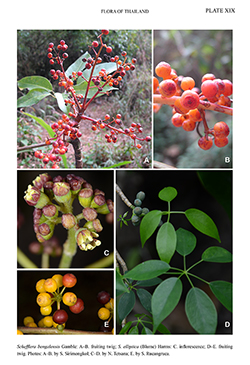e-Flora of Thailand
Volume 14 > Part 2 > Year 2019 > Page 227 > Araliaceae > Schefflera
5. Schefflera elliptica (Blume) Harmswfo-0000305848
in Engl. & Prantl, Nat. Pflanzenfam. 3.8: 39. 1894; R.Vig., Ann. Sci. Nat., Sér. 9, Bot. 9: 349. 1909; in Lectome, Fl. Indo-Chine 2(9): 1174. 1923; Craib, Fl. Siam. 1: 798. 1931; Rehder, J. Arnold Arbor. 15: 114. 1934; Grushv. & Skvortsova, Adansonia n.s. 9: 379. 1969; Frodin in Whitmore, Tree Fl. Malaya 3: 29. 1978; C.B.Shang, Candollea 39: 468. 1984, excl. syn.; P.H.Hô, Câyco Viêtnam 2: 615, pl. 5378. 1993; Frodin in Frodin & Govaerts, World Checkl. Bibliogr. Araliac.: 336. 2004 (‘2003’); C.B.Shang & Lowry, Fl. China 13: 459. 2007; S.Gardner et al., Forest Trees S. Thailand 1: 234, fig. 330. 2015. Plate XIX: C–E.
Synonyms & Citations :
Description : Climber or epiphyte to 3 m tall; bark silvery grey. Leaves glabrous; stipules ca 5–6 mm long, with a short free rim; petiole 6–15 cm long; leaflets (3–)5–7, their petiolules (1.5–)3–7 cm long, variable within the same leaf, elliptic (hardly obovate), 8–17 by 4–7(–10) cm, hardly variable within the same leaf, chartaceous, base acute to obtuse (sometimes attenuate), margin entire, apex short-acuminate, slightly paler beneath, venation distinct, side veins in 4–7 pairs. Inflorescence terminal or sub-terminal; at base with some rounded-triangular bract scales ca 8–15 by 10–12 mm, these densely tomentose and each one originally supporting a side branch, caducous; inflorescence main axis 1–5(–9) cm long, 0.3–0.5 cm thick near base, with scattered, dendritic, creamish hairs to 0.4 mm long near the base but glabrous apically; whole inflorescence ca 8–12 cm long, with 3–7 branches of which 2–4 are crowded at the very base, the branches (sub-)glabrous; branches 5–18 cm long, bearing 5–13 umbels; bracts ca 10 mm long, thin, glabrous, very soon caducous; umbel peduncle 0.5–1.6(–2.5) cm long, without additional bracts; umbels 8–10 mm in diam. (in fruit to 20 mm), with 7–16 flowers. Flowers pale green to yellowish, purple tinted, fragrant; (sub-)glabrous; bracts caducous, not seen; pedicel 2–5 mm long; calyx entire; petals 5, ovate, 1.5–2.5 by 1 mm, free; anthers 5, to 1 mm, filaments to 3 mm long; receptacle turbinate, glabrous or with scattered branched hairs; disc rounded-conical, 1 to 1.5 mm across; stigmas 5, pulvinate, sessile. Fruits glabrous; pedicel 3–8 mm long; drupe ovoid to globose, 3.5–5 by 3–4 mm, 5-locular, deeply sulcate; perianth scar 3/4trs from base; yellow to orange with red stigmas.
Thailand : NORTHERN: Mae Hong Son, Chiang Mai, Lamphun, Lampang, Phrae, Tak, Sukhothai, Phitsanulok, Nakhon Sawan; NORTH-EASTERN: Loei, Udon Thani, Sakon Nakhon, Khon Kaen; EASTERN: Chaiyaphum, Nakon Ratchasima, Mukdahan, Si Sa Ket; SOUTH-WESTERN: Kanchanaburi; CENTRAL: Nakhon Nayok; SOUTH-EASTERN: Prachin Buri, Chon Buri, Chanthaburi, Trat; PENINSULAR: Chumphon, Ranong, Surat Thani, Phangnga, Phuket, Krabi, Nakon Si Thammarat, Trang, Satun, Songkhla, Pattani, Narathiwat.
Distribution : Taiwan and Myanmar through Indochina and large parts of Malesia (type from Java) to Australia (Queensland).
Ecology : Often very common on sandy sea-shores, in coastal forests or on rocks, lowland evergreen forets, also along rivers, sometimes penetrating inland along river courses, on higher altitudes in deciduous dipterocarp oak forests, primary or degraded seasonal evergreen or mixed evergreen deciduous hardwood forests, over granitic, sandstone or limestone bedrock, sea level to 800(–1,300) m alt. Flowering: the whole year through but mostly January–April; fruiting: November–May, August.
Vernacular : Mue narai (มือนารายณ์)(Ranong); nio mue phra narai (นิ้วมือพระนารายณ์)(Chaiyaphum, Peninsular); mue phra ruesi (มือพระฤๅษี)(North-eastern); li-do-mae-woa (Narathiwat); nuat pla muek (หนวดปลาหมึก)(Udon Thani).
Uses: Leaves, stem and root are boiled, the liquid is applied for painful joints and muscles.
Notes: 1. Shang (1984) reduced Schefflera bengalensis to this species. It is clear that the two species are not only distinct morphologically, but are ecologically well separated. The inflorescence of S. elliptica is much smaller, with less persistent bracts, and the fewer racemes are mostly borne near the base, unlike S. bengalensis which has a straight robust peduncle which dries dark with prominent white lenticels, and with the racemes borne near the apex only. A specific character shown by S. elliptica are the large, densely pubescent lower bracts of the inflorescence, and in the absence of these, the lowermost nodes of the peduncle are likewise densely pubescent, compared to the sparse to glabrous nature of the remainder of the inflorescence. In S. bengalensis the inflorescence is evenly glabrous or sparsely pubescent, and the bracts are nearly glabrous, and are not noticeably larger at the base.
2. Although the majority of collections are coastal, there are a few inland localities. Most of these collections are from below 500 m, although very few were collected up to 1,300 m. A number of these were assigned to Schefflera clarkeana by Craib.
3. Plants from Java (the type locality) differ in longer pedicels and peduncles as well as in generally 6-locular ovaries and fruits.
E-version notes : Heptapleurum ellipticum (Blume) Seem.
J. Bot. 3: 78. 1865.—Sciodaphyllum ellipticum Blume, Bijdr. Fl. Ned. Ind.: 878. 1826; DC., Prodr. 4: 260. 1830.—Paratropia elliptica (Blume) Miq., Bonplandia 4: 138. 01 May 1856; Fl. Ned. Ind. 1.1: 75. 10 July 1856.

